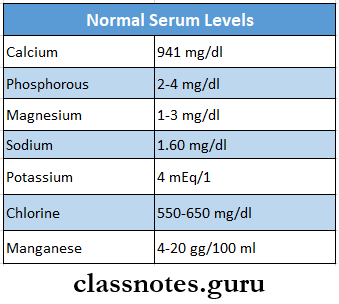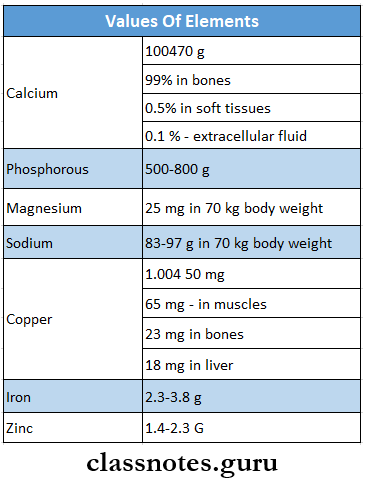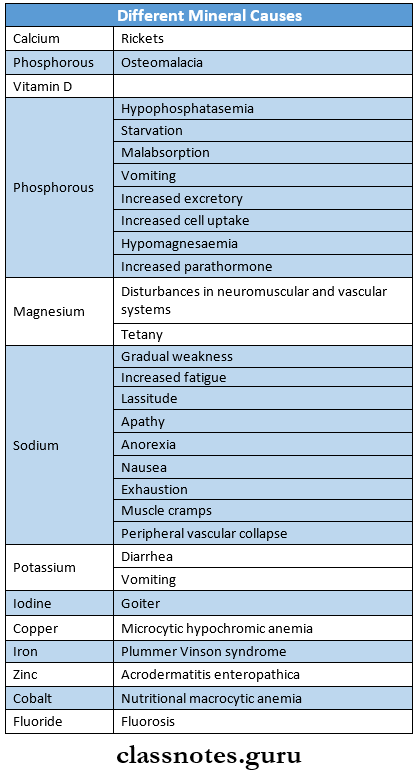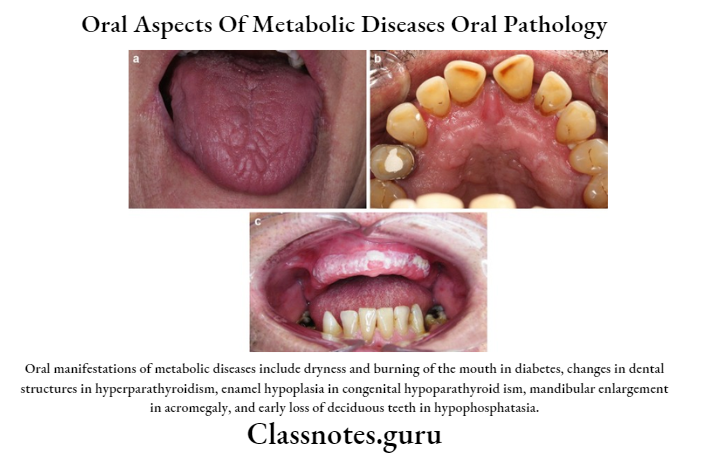Oral Aspects Of Metabolic Diseases Important Notes
1. Normal Serum Levels

2. Total Values Of Elements In The Body

3. Daily Requirements

4. Deficiencies Of Different Minerals Cause

5. Types Of Calcium In Plasma
- Ionized form
- Protein-bound
- Complex form
6. Selenium-Containing Amino Adds
- Selenomethionine
- Selenocysteine
- Selenocysteine
7. Progeria
- Described by Hutchison in 1886
- Characterized by dwarfism and premature senility
- Clinical features
- Manifestations begin within 1st few years
- Alopecia
- Pigmented areas of the trunk
- Atrophic skin
- Prominent veins
- Loss of subcutaneous fat
- High-pitched squeaky voice
- Beak like nose
- Hypoplastic mandible
- Coxa valga
- Exophthalmos
- Muscular atrophy
- Joint deformities
- Intelligence is normal or above normal
- The patient resembles wizened little old person at a very early age
- No patient lives beyond the age of 27 years
- Oral manifestations
- Accelerated formation of irregular dentin
- Delayed eruption of teeth
Read And Learn More: Oral Pathology Question And Answers
8. Vitamins

Oral Aspects Of Metabolic Diseases Short Question And Answers
Question 1. Hypopituitarism
Answer:
Hypopituitarism
Hypopituitarism is a condition of deficiency of the pituitary hormone
Hypopituitarism Causes:
- Tumor of pituitary
- Hypophyseal fibrosis
- Suprasellar cyst
- Destruction of pituitary gland
Hypopituitarism Clinical Features:
- Short stature of the body
- The presence of fine, silky, sparse hair over body
- Wrinkled atrophic skin
- Hypogonadism
- Extreme weight loss
- Coma and death in severe cases
Hypopituitarism Oral Manifestations:
- Small face
- Delayed exfoliation of deciduous teeth
- Delayed root completion
- Delayed eruption of permanent teeth
- Hypofunction of the salivary gland
- Decreased salivary flow
- Increased caries activity and periodontal disease
- Crowding of teeth
- Underdevelopment of maxilla, mandible, and 3rd molars
- Smaller crown size and root length of teeth
Hypopituitarism Diagnosis:
- Hypoglycaemia
- Decreased serum growth hormone levels
- Skull X-ray- reveals tumor in cellar region
- CT scan and MRI- detects brain tumor
Hypopituitarism Treatment:
- Correction of skeletal and dental malocclusion
- Fluoride application
- Corticosteroids
Question 2. Hyperpituitarism
Answer:
Hyperpituitarism
- Hyperpituitarism is an increased production of growth hormone
- Hyperpituitarism results in gigantism in infants and acromegaly in adults
Hyperpituitarism Etiology:
- Pituitary adenoma
- Increased function of anterior pituitary
Hyperpituitarism Clinical Features:
- Gigantism
- Overgrowth of body
- Excessive perspiration
- Headache
- Lassitude
- Fatigue
- Muscle and joint pain
- Defective vision
- Genital underdevelopment
- Hypertension
- Acromegaly
- Thick bones with larger hands and feet
- Increase in rib size
- Barrel shaped chest
- Temporal headache
- Increased intracranial tension
- Photophobia
- Blurred vision
- Hepatomegaly, cardiomegaly
- Osteoporosis
- Arthralgia, myalgia
- Bowing of legs
Hyperpituitarism Oral Manifestations:
- Gigantism
- Broad, enlarged nose
- Enlarged maxilla and mandible
- Large size of teeth and root
- Macroglossia
- Class 3 malocclusion
- Interdental spacing
- Hypercementosis
- Acromegaly
- Anterior open bite
- Class 3 xnalocclusion
- Macroglossia
- Thick lips
- Ordination of teeth
- Hypercementosis
- Enlargement of maxillary air anuses
- Large nose, ears, and prominent eyebrows
- Increase in thickness of jaw bones
- Increased incidence of periodontitis
Hyperpituitarism Diagnosis:
- Increased serum inorganic phosphorous level
- GlyCosuria
- Hypercaldnuria
- T4 level- reduced or normal
- Serum growth hormone level-increased
- Hyperphosphatemia
Question 3. Addison’s disease
Answer:
Addison’s Disease
Addison’s disease is a debilitating and potentially fatal condition occurring due to chronic insufficiency of the adrenocortical hormone
Addison’s Disease Clinical Features:
- Lethargy, fatigue, muscular weakness
- Vomiting, diarrhea
- Severe anaemia
- Irregular menstruation
- Loss of body hair
- Dehydration
- Hypertension
- Postural dizziness
- Brownish discoloration of skin and oral mucosa
- Small and feeble pulse
- Chronic mucocutaneous candidiasis
Addison’s Disease Diagnosis:
- Acanthosis with silver-positive granules in epithelial cells
- Low diurnal plasma cortisol level
- ACTH level reduced
- Serum potassium elevated

Question 4. Diabetes mellitus
Answer:
Diabetes Mellitus
Diabetes mellitus is a metabolic disorder due to glucose intolerance
Diabetes Mellitus Clinical Features:
- Polyuria
- Glycosuria
- Polydipsia
- Nocturia
- Weakness
- Weight loss
- Tiredness
- Increased susceptibility to infections Pain and paraesthesia in limbs
Diabetes Mellitus Oral Amnrfestations:
- Gingival hyperplasia
- Dry mouth
- Multiple carious lesion
- Candidiasis
- Delayed wound healing
- Dry socket formation
- Burning mouth syndrome
- Painless, recurrent swelling of salivary gland
- Erosive lichen planus
- Loss of taste sensation
- Enamel hypoplasia
- Atypical tooth pain
- Benign migratory glossitis
Diabetes Mellitus Diagnosis:
- Blood sugar estimation
- Glucose tolerance test- above 130 mg/dl
- Urinary glucose estimation-above 10-20 mg/dl
- Presence of ketone bodies in urine
Diabetes Mellitus Treatment:
- Diet control
- Oral hypoglycaemic drugs
- Insulin therapy
Question 5. Scurvy
Answer:
Scurvy
Deficiency of vitamin C leads to scurvy
Scurvy Clinical Features:
- Fatigue
- Bruising
- Premature loss of hair
- Joint pain and swelling
- Intrabony haemorrhage
- Hematoma formation
- Disturbed bone growth
- Follicular hyperkeratosis
- Retardation of wound healing
- Swelling in legs
Scurvy Oral Manifestations:
- Petechiae and echymosis of oral mucosa
- Color of gingiva- bright red
- The surface of gingiva- swollen, smooth, shiny
- Gingiva becomes boggy, ulcerated, and bleeds
- Foul breath
- Loss of bone
- Loosening of teeth
- Difficulty in taking food
- Premature exfoliation of deciduous teeth
- Weak attachment between bone and periosteum
Question 6. Oral manifestations of hyperparathyroidism
Answer:
Oral Manifestations Of Hyperparathyroidism
- Loosening and mobility of teeth
- Fracture of jawbones
- Swelling of the jaw
- Development of brown tumour
Question 7. Rickets
Answer:
Rickets Clinical Features:
- The gross skeletal change depends on the severity of the rachitic process, its duration, and in particular the stresses to which individual bones are subjected.
- Craniotabes, are the earliest bony lesion occurring due to small round unossified areas in the membranous bones of the skull.
- Harrisons sulcus occurs due to in drawing of soft ribs on inspiration.
- Pigeon chest deformity
- Bow legs occur in ambulatory children due to weak bones of the lower legs.
- Knocked knees may occur due to enlarged ends of the femur, tibia, and fibula.
- Lower epiphyses of radius may be enlarged.
- Lumbar lordosis due to involvement of the spine and pelvis.
Question 8. Pellagra
Answer:
Pellagra
- Niacin deficiency causes Pellagra i.e. naught skin.
- The cardinal manifestations of pellagra are referred to as three Ds i.e., dermatitis, diarrhea, and dementia and if not treated may lead to 4th D i.e., death.
- Dermatitis: Sun-exposed areas of skin developed erythemia resembling sunburn which may progress to chronic type with blister formation.
- Diarrhea: This is seen along with stomatitis, glossitis, enteritis, nausea, and vomiting.
Dementia: Degeneration of neurons of the brain of the spinal tract results in neurological symptoms such as dementia, peripheral neuritis, ataxia, and visual and auditory disturbances.
- Oral findings include:
- Bald tongue of sandwich,
- Raw beefy tongue
- Mucosa becomes fiery red and painful
- Profuse salivation.
- Chronic alcoholics are at high risk of developing pellagra because in addition to dietary deficiency, niacin absorption is impaired in them.
Question 9. Amyloidosis
Answer:
Amyloidosis
- Amyloidosis is the term used for a group of diseases characterized by the extracellular deposition of a fibrillar proteinaceous substance called amyloid having a common morphological appearance, staining properties, and physical structure but with variable protein composition.
Amyloidosis Features:
- Smooth surfaces, waxy papules over lips, eyelids, and neck
- Macroglossia
- Gingival swelling
- Formation of ulcers
- The surface of lesion- pale and purplish
- Petechiae and ecchymosis of oral mucosa
- Claudication
- Xerostomia
- Dryness of mouth
Question 10. Hyperthyroidism
Answer:
Hyperthyroidism
Hyperthyroidism is caused by the excessive production of the thyroid hormone
Hyperthyroidism Clinical Features:
- Tremors
- Tachycardia
- Sweating
- Weight loss
- Nervousness
- Muscle weakness
- Heat intolerance
- Exophthalmia
- Alveolar atrophy
- Hypertension
- Excitability, anxiety, and irritability
- Photophobia
- Premature eruption of permanent teeth
- Early exfoliation of deciduous teeth
- Increased susceptibility to oral infections
Question 11. Pituitary Dwarfism
Answer:
Pituitary Dwarfism Clinical Features:
- Short stature of the body
- The presence of fine, silky, sparse hair over body
- Wrinkled atrophic skin
- Hypogonadism
- Extreme weight loss
- Coma and death in severe cases
Pituitary Dwarfism Oral Manifestations:
- Small face
- Delayed exfoliation of deciduous teeth
- Delayed root completion
- Delayed eruption of permanent teeth
- Hypofunction of salivary gland
- Decreased salivary flow
- Increased caries activity and periodontal disease
- Crowding of teeth
- Underdevelopment of maxilla, mandible, and 3rd molars
- Smaller crown size and root length of teeth
Question 12. Eosinophilic granuloma
Answer:
Eosinophilic Granuloma
Eosinophilic granuloma is a chronic, localized form of bone disorder
Eosinophilic Granuloma Clinical Features:
- Fever, malaise
- Headache
- Anorexia
- Local pain, swelling, and tenderness in jaw bones
- Swelling of gingival tissues
- Halitosis
- Mobility of teeth
- Eosinophilic granuloma Radiographic Features:
- Appears ns irregular radiolucent areas
- Cortex is destroyed
- Pathologic fractures occur
- Single or multiple areas of destruction appear as hanging in the air
Oral Aspects Of Metabolic Diseases Viva Voce
- Magnesium is 4th most abundant element in the body
- Calcium is 5th most abundant element in the body
- Bantu sideroses result from the ingestion of homemade beer fermented in iron pots
- Bronze diabetes occurs due to iron overload
- Protein-energy malnutrition is kwashiorkor and marasmus
- Lack of adequate bone matrix causes osteoporosis
- Porphyria is an inborn error of porphyrin metabolism
- Vitamins is defined as an organic substance not made by the body which is soluble in either fat or water and is ordinarily needed in only minute quantities to act as a cofactor in a variety of metabolic reactions.
